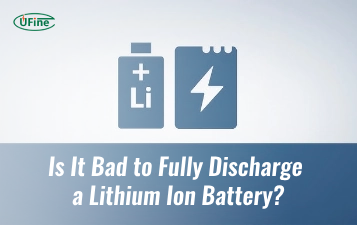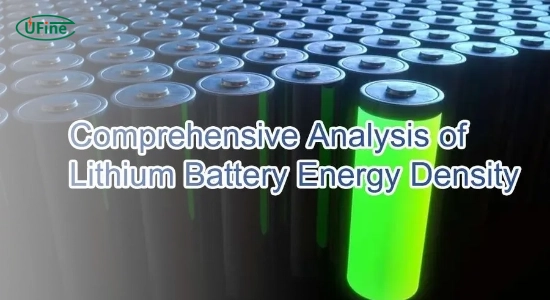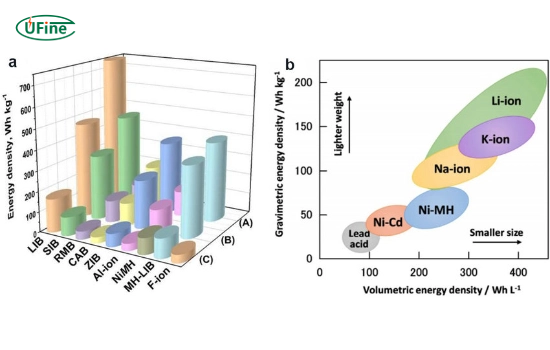
- Part 1. What is the energy density of a lithium-ion battery?
- Part 2. Key factors boosting lithium-ion battery energy density
- Part 3. Types of lithium-ion batteries and their energy density
- Part 4. Future of lithium-ion battery energy density
- Part 5. FAQs about energy density of a lithium-ion battery
Lithium-ion batteries are crucial for phones and cars because they store a lot of energy. Energy density means how much power they can keep in a small space or weight. Knowing about energy density is important because it affects how well these batteries work, how long they last, and how we can use them for different purposes.
Energy density (measured in Wh/kg or Wh/L) determines how much power a lithium-ion battery stores for its size/weight. Higher density enables:
- Longer driving ranges for electric vehicles
- Extended usage time for smartphones/laptops
- Compact designs in portable devices
| Battery Type | Energy Density (Wh/kg) | Best For |
|---|---|---|
| Standard Lithium-Ion | 150-250 | EVs, Laptops |
| Lithium-Polymer | 100-200 | Wearables |
| Future Target | 300+ | Next-gen EVs |
Quick Answer: The energy density of a lithium-ion battery typically ranges from 150–250 Wh/kg (gravimetric) and 300–700 Wh/L (volumetric). This metric shows how much energy a battery stores per unit weight or volume, directly affecting EV driving range and device runtime.
Part 1. What is the energy density of a lithium-ion battery?
The energy density of a lithium-ion battery measures stored energy per unit mass (Wh/kg) or volume (Wh/L):
- Gravimetric (Wh/kg): Critical for EVs where weight matters (150-250 Wh/kg typical)
- Volumetric (Wh/L): Key for smartphones (300-700 Wh/L typical)
This core metric directly determines your EV’s range or phone’s battery life per charge.
Average Energy Density Metrics
Lithium-ion batteries commonly exhibit energy densities ranging between 150 to 250 watt-hours per kilogram (Wh/kg) or 300 to 700 watt-hours per liter (Wh/L). Newer lithium-ion chemistries such as NMC 811 or silicon-dominant anodes are pushing energy density beyond 250 Wh/kg. In research labs, volumetric energy density of lithium-ion batteries can exceed 750 Wh/L, approaching next-generation solid-state benchmarks.
Part 2. Key factors boosting lithium-ion battery energy density
1. Electrode Materials: Core Performance Drivers
The choice of cathode (NMC/NCA) and anode (silicon/graphite) materials primarily determines maximum energy density potential.
2. Cell Design: Space Optimization
Efficient electrode stacking and compact design increase active material percentage, boosting Wh/kg and Wh/L metrics.
3. Electrolyte Chemistry: Voltage & Stability
Advanced electrolytes enable higher operating voltages (increasing Wh/kg) while maintaining safety – solid-state electrolytes show particular promise.
4. Packing Efficiency
The packing density and the efficiency of space utilization within the battery cell greatly influence energy density. Maximizing the active material content and minimizing inactive components such as binders and conductive additives contribute to achieving higher energy densities.
5. Temperature and Operating Conditions
Temperature significantly affects the performance and energy density of lithium-ion batteries. Extreme temperatures can impact the efficiency of ion movement, electrode reactions, and overall cell performance. Maintaining an optimal operating temperature range is crucial for achieving and preserving high energy density.
6. State of Charge and Cycling Behavior
The energy density of lithium-ion batteries can vary with the state of charge and the number of charge-discharge cycles. Cycling behavior, including depth of discharge and charging rates, can affect the degradation of active materials, impacting energy density over the battery’s lifespan.
Part 3. Types of lithium-ion batteries and their energy density
1 Lithium-ion vs. Lithium-Polymer
Lithium-ion Battery:
Lithium-ion batteries typically exhibit energy densities ranging between 150 and 250 watt-hours per kilogram (Wh/kg) or 300 to 700 watt-hours per liter (Wh/L). Owing to their relatively high energy density, these batteries are extensively used in many applications. Due to their energy-to-weight and energy-to-volume ratios, they power smartphones, laptops, electric vehicles, and even grid storage systems.
Lithium-Polymer Battery:
Lithium-polymer batteries, a subset of lithium-ion technology, have energy densities slightly lower than conventional lithium-ion variants. They typically range between 100 and 200 Wh/kg or 200 and 400 Wh/L. Despite their marginally reduced energy densities, their advantage lies in their flexibility, allowing for thinner and custom-shaped designs. This characteristic makes them suitable for applications where space and form factor flexibility are critical.
Lithium Iron Phosphate Battery(LiFePO4):
LiFePO4 batteries, while possessing slightly lower energy densities than conventional lithium-ion variants, usually range between 90 and 120 Wh/kg or 180 and 240 Wh/L. Their primary strength lies in their robust safety profile and longevity. These batteries are well-suited for applications where safety and stability are paramount, such as in power tools, medical devices, and stationary energy storage systems.
2 Other Lithium Batteries
Lithium-Sulfur Battery (Li-S):
Li-S batteries boast a theoretical energy density of up to 500 Wh/kg or higher, surpassing most traditional lithium-ion variants. However, practical implementations currently achieve energy densities ranging between 300 to 350 Wh/kg. Challenges related to sulfur cathode degradation and cycle life hinder their widespread commercialization.
Lithium-Air Battery (Li-Air):
Li-Air batteries exhibit remarkable theoretical energy densities surpassing 1000 Wh/kg. However, practical limitations related to electrolyte stability and electrode design have limited their real-world energy densities to experimental levels, currently achieving around 500 Wh/kg in research settings.
Lithium-Titanate Battery (Li4Ti5O12):
Li-Titanate batteries exhibit lower energy densities, typically between 70 and 100 Wh/kg or 100 and 150 Wh/L. However, they compensate with exceptional charge-discharge rates, long cycle life, and enhanced safety. These batteries find applications in scenarios prioritizing rapid charging, such as electric vehicles and grid storage systems requiring high power output.
| Battery Chemistry | Gravimetric (Wh/kg) | Volumetric (Wh/L) | Best Applications |
|---|---|---|---|
| Lithium-Ion (Li-ion) | 150-250 | 300-700 | EVs, Laptops, Power Tools |
| Lithium-Polymer (LiPo) | 100-200 | 200-400 | Wearables, Thin Devices |
| LiFePO4 | 90-120 | 180-240 | Safety-Critical Systems |
Standard lithium-ion batteries deliver the highest practical energy density for most applications.
Summary: Among all current lithium chemistries, lithium-ion (150–250 Wh/kg, 300–700 Wh/L) provides the best balance of weight, volume, and performance, making it the leading choice for EVs and electronics.
Part 4. Future of lithium-ion battery energy density
Next-gen technologies targeting 300+ Wh/kg energy density:
- Solid-State Batteries: Safer lithium metal anodes (400-500+ Wh/kg potential)
- Silicon-Dominant Anodes: 10x higher capacity than graphite
- Nickel-Rich Cathodes: NMC 811/9½½ formulations
Companies like Tesla and CATL aim to commercialize 300+ Wh/kg batteries by 2025-2027.
For custom lithium battery solutions, optimizing both gravimetric and volumetric energy density is key to meeting application-specific needs.
Part 5. FAQs about energy density of a lithium-ion battery
What is the energy density of a lithium-ion battery?
The energy density measures stored energy per unit weight (Wh/kg) or volume (Wh/L). Commercial lithium-ion batteries typically achieve 150-250 Wh/kg and 300-700 Wh/L. These values vary by chemistry and design, but most EV batteries today use cells around 230–250 Wh/kg.
What’s the highest energy density for lithium batteries?
Standard lithium-ion (NMC/NCA) offers the highest practical density at 230-250 Wh/kg. Lithium-sulphur promises 500+ Wh/kg theoretically, but isn’t commercially viable yet.
How does energy density affect EV range?
Every 10% increase in Wh/kg adds ~15% more range. Current 250 Wh/kg batteries provide ~300 miles; 300+ Wh/kg will enable 450+ mile ranges.
Lithium-ion vs LiPo: Which has better energy density?
Lithium-ion batteries provide 150-250 Wh/kg, compared to LiPo batteries’ 100-200 Wh/kg. LiPo’s advantage is flexible packaging, not energy density.
Will solid-state batteries improve energy density?
Yes. Solid-state batteries with lithium metal anodes could reach 400-500 Wh/kg, nearly double the current lithium-ion energy density.
What is the volumetric energy density of a lithium-ion battery?
Commercial lithium-ion batteries reach 300–700 Wh/L in volumetric energy density. Smartphones and laptops rely on this metric, while EVs emphasize gravimetric density (Wh/kg). Future designs aim to surpass 750 Wh/L with solid-state electrolytes.
Related Tags:
More Articles

Is It Bad to Fully Discharge a Lithium Ion Battery?
Discover what happens if a lithium battery is fully discharged and how to safely recharge 12V batteries to prevent permanent damage.
Does a Higher mAh Battery Last Longer?
Does a higher mAh battery really last longer? Learn what mAh means, real battery life in hours, replacement safety (4000 vs 5000mAh), and real examples.
Exploring the Lithium Ion Battery Fire Temperature
Discover the lithium-ion battery fire temperature and learn how to stay safe. Get essential tips to prevent battery fires and protect your devices today.
The Ultimate Guide to 6s Lipo Batteries
A beginner-friendly guide to 6S LiPo batteries. Understand voltage, capacity, charging tips, safety rules, and real-world applications.
What is the NCMA battery? What is the difference between it and the NMC battery? Which one is better? This article will answer your questions.




